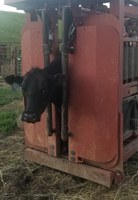Consider Pregnancy Testing Beef Cattle Early
(Click the image below to view a high-resolution image that can be downloaded)
The breeding season for spring-calving cow herds in North Dakota could run from March through late summer or early fall, depending on the desired time of calving and length of the breeding season.
“Regardless of the length of the breeding season, reproductive efficiency is a critical factor in maintaining a profitable ranch operation,” says Janna Block, Extension livestock systems specialist based at North Dakota State University’s Hettinger Research Extension Center.
“Pregnancy testing is one method that can be used to monitor reproductive performance and help make appropriate management decisions,” she adds. “For instance, during a drought, late-bred or open cows can be identified early and sold to reduce feeding costs.”
Although pregnancy testing typically is carried out in late summer or fall, it can be conducted as early as 30 to 45 days after the end of the breeding season through ultrasound, rectal palpation or blood-based pregnancy tests. Pregnancy testing cows early provides a number of benefits.
“The ability to identify nonpregnant cows close to the end of the breeding season can help with culling decisions,” says Karl Hoppe, livestock systems specialist based at NDSU’s Carrington Research Extension Center. “If overall pregnancy rates are low in a certain group or pasture, producers can begin the process of determining if problems are related to bull fertility, disease or nutritional issues. Additionally, abnormalities such as cystic ovaries and infections that affect reproductive performance may be identified.”
Typically, ultrasound can be used at around 30 days post-breeding, while palpation would be most useful one to two weeks later. The experience level of the technician and the method used will determine the earliest date that tests can be conducted.
Blood-based pregnancy tests are another option for pregnancy diagnosis that can be used within 60 to 90 days post-calving and 25 to 30 days post-breeding, depending on the type of test used. Test kits can be purchased from several commercial sources, and the producer can collect blood samples on the ranch.
Most blood samples have to be sent to a certified laboratory for detection of pregnancy-related proteins; however, some blood testing kits that are designed for veterinary practice can be read visually within about 30 minutes with no additional equipment needed. Because the proteins of interest remain in the cow after calving, the previous pregnancy can cause interference if the recommended sampling period is not followed.
For example, assume a group of heifers was artificially inseminated on April 15 and then exposed to a cleanup bull for 30 days. Because heifers have not had a previous pregnancy, a blood test or ultrasound could be conducted around the middle of June or palpation could be conducted at the end of June. If mature cows were exposed to the same breeding protocol, the earliest a blood test could be conducted would be the middle of July.
“There are advantages and disadvantages for each method of pregnancy testing,” says Gerald Stokka, NDSU Extension veterinarian and livestock stewardship specialist. “Costs are typically similar among methods; however, it is important to evaluate options due to variation in prices among veterinarians and laboratories.”
Blood-based tests do not require an experienced technician or specialized equipment to collect the samples. However, some kits require additional time for samples to be shipped and processed at a laboratory.
For quick-response blood tests, animals must be put in a holding pen while pregnancy status is determined, and additional sorting may be required. The required interval between calving and blood sampling means that other methods could be used earlier in most cases. In addition, false positives may be seen for several days after a cow has undergone an abortion.
Rectal palpation and ultrasound can determine pregnancy immediately without extra handling. Additionally, these methods can be used to determine the age of the fetus and monitor reproductive organs, while blood tests cannot. Ultrasound also can be used to determine the sex of the fetus and incidence of twins.
The specialists note that the frequency of embryonic mortality typically is highest within the first 42 days of pregnancy. In some cases, producers have attributed abortions to rough handling of the fetus and/or membranes when pregnancy testing; however, differentiating these potential losses with “normal” embryonic loss is extremely difficult.
For cattle in early pregnancy, producers should minimize handling, transportation and heat stress to reduce the risk of abortions. If necessary, an additional pregnancy check conducted before winter feeding programs begin can identify cows that have lost pregnancies.
Producers have a variety of options for managing nonpregnant cows and heifers. Open cows can be weaned early and sold, moved into a fall calving cow herd or held back for a later marketing opportunity to avoid seasonal lows of cull cow prices. Open heifers can be removed from grass or feed and sold immediately, be retained and bred for a later calving season, or be managed and sold as feeders. Current cattle markets, weather outlooks and feed availability are all factors that should be considered when determining the fate of nonpregnant females.
“Regardless of the management decisions made after pregnancy checking occurs, early diagnosis will add to a producer’s bottom line by identifying nonproductive females and reducing associated feed and production costs,” Block says. “Early pregnancy testing also can identify reproductive issues within a herd and allow for a more thorough and effective response.
Producers should consult their veterinarian to make informed decisions about what method is best suited to their individual operation and goals.”
NDSU Agriculture Communication - July 9, 2020
| Source: | Janna Block, 701-567-4323, janna.block@ndsu.edu |
|---|---|
| Source: | Karl Hoppe, 701-652-2951, karl.hoppe@ndsu.edu |
| Source: | Gerald Stokka, 701-231-5082, gerald.stokka@ndsu.edu |
| Editor: | Ellen Crawford, 701-231-5391, ellen.crawford@ndsu.edu |


